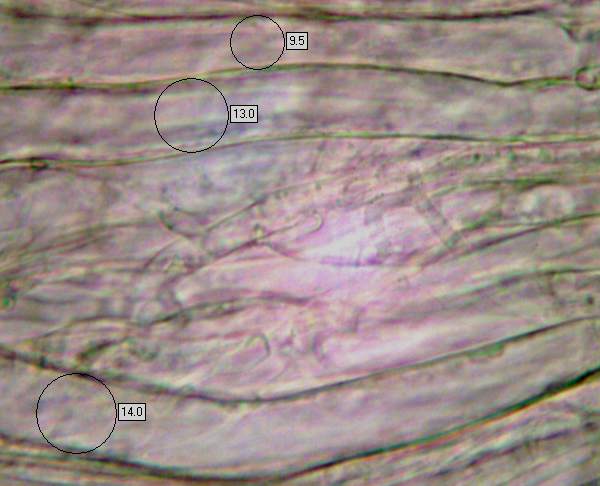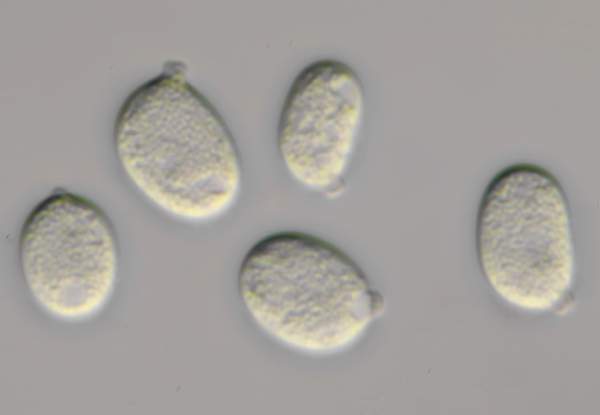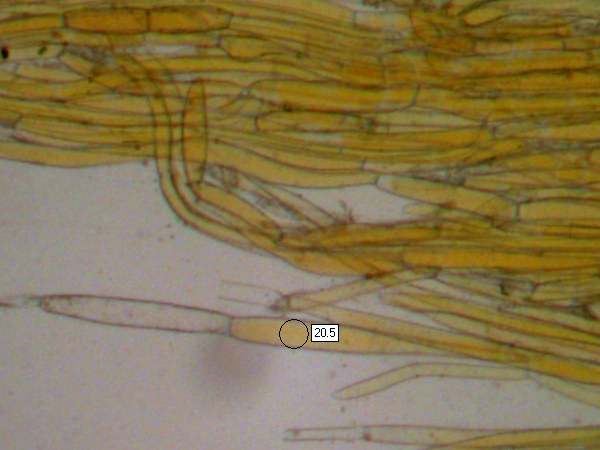Hygrocybe intermedia (Pass.) Fayod - Fibrous Waxcap
Phylum: Basidiomycota - Class: Agaricomycetes - Order: Agaricales - Family: Hygrophoraceae
Distribution - Taxonomic History - Etymology - Identification - Culinary Notes - Reference Sources
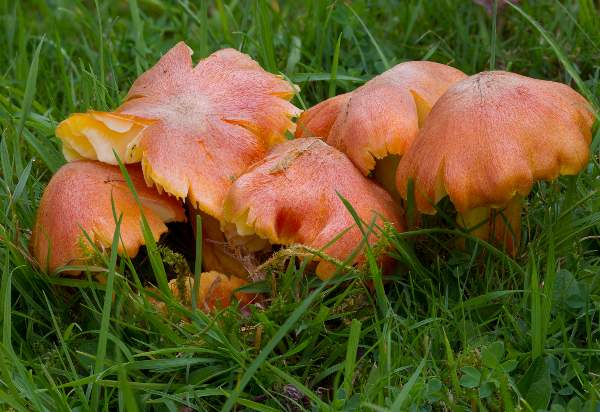
The Fibrous Waxcap is distinguished by its large size, dry scurfy cap surface and dry fibrous stem. This waxcap is an uncommon to occasional find in most of Britain and Ireland except in some parts of Wales, where it is more frequently recorded.
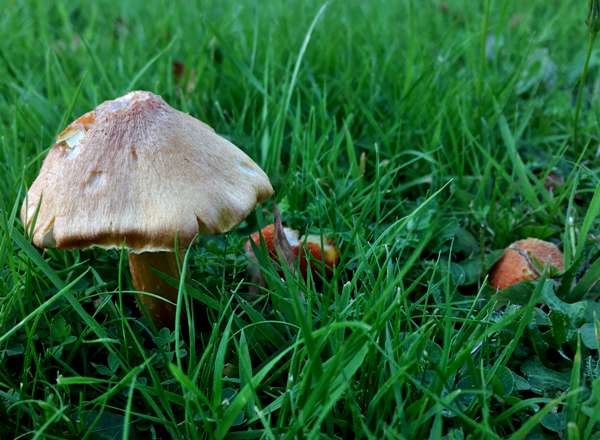
Distribution
Hygrocybe intermedia occurs throughout Britain and Ireland, where it is most often seen in unimproved grassland and, occasionally, in sand-dune systems. This species occurs on mainland Europe from Scandinavia down to southern France and Italy, but it is uncommon to rare throughout its range.
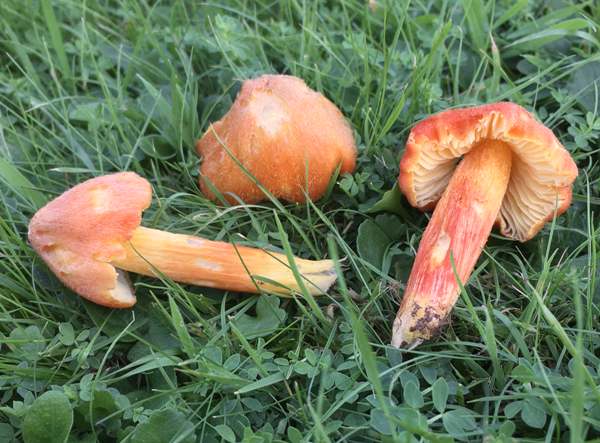
Taxonomic history
Originally described in 1872 by Italian botanist Giovani Passerini (1816 - 1893), who named it Hygrophorus intermedius, the Fibrous Waxcap was relocated to its present genus in 1889 by Swiss mycologist Victor Fayod (1860 - 1900), thereby establishing its currently-accepted scientific name as Hygrocybe intermedia.
Synonyms of Hygrocybe intermedia include Godfrinia intermedia (Pass.) Herink and Pseudohygrocybe intermedia (Pass.) Kovalenko, Mikol.
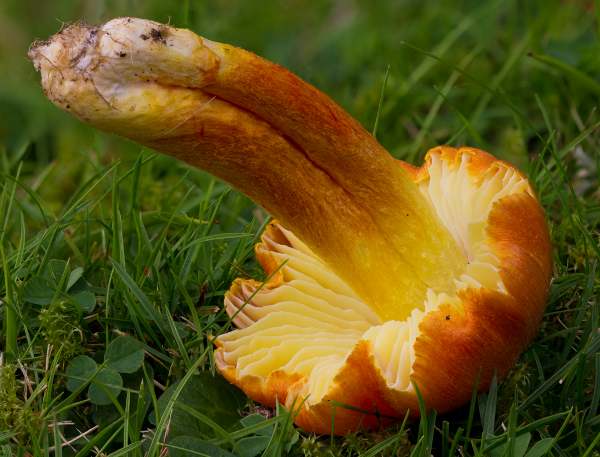
Etymology
The genus Hygrocybe is so named because fungi in this group are always very moist. Hygrocybe means 'watery head'. The specific epithet intermedia comes from the Latin inter and media which translate to 'in the middle'.
Identification guide
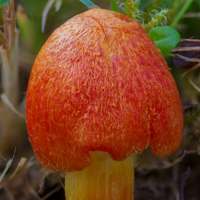 |
Cap3 to 9cm in diameter, the cap is broadly conical at first, becoming convex and eventually almost flat, sometimes splitting at the margin. Initially the cap colour is reddish, becoming orange-yellow with a paler margin at maturity. The cap surface is dry and scurfy with radial fibrils. Flesh yellowish. |
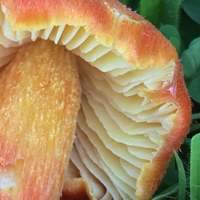 |
GillsAdnexed or free, thick, moderately spaced, whitish to pale yellow sometimes with an orange tinge; gill edges often serrated. StemOrange-yellow on the surface and streaked with reddish longitudinal fibres. Dry, cylindrical and uusually hollow, with no stem ring; 0.5 to 2cm in diameter and 3 to 9cm tall. |
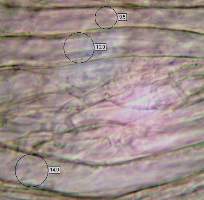 |
Gill tramaRegular, with hyphal elements 200 - 700μm long x 9 - 15μm in diameter. |
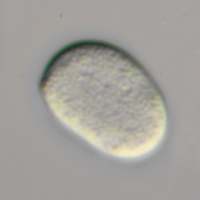 |
SporesOvoid, pyriform (pear shaped) or broadly ellipsoidal, 8-11 x 5-6.5μm; inamyloid. Spore printWhite. |
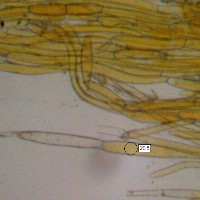 |
PileipellisA slightly differentiated cutis with surface squamules comprising fascicules of erect hyphal cells with tapering terminal hyphal elements 80 - 240 long x 10 - 30μm diameter. |
Odour/taste |
Not distinctive. |
Habitat & Ecological role |
In unimproved grassland on alkaline to mildly acidic soils. |
Season |
July to November in Britain and Ireland. |
Similar species |
Hygrocybe chlorophana has a smooth cap that is slimy in wet weather. Hygrocybe reidii has a smooth cap; its crushed gills smell like honey. Hygrocybe acutoconica is usually more yellow and has a smooth cap surface but a fibrous stem; its spores are more cylindrical (Q value typically 1.9 compared with typically 1.6 for Hygrocybe intermedia.) |
Culinary Notes
On a Europe-wide scale waxcap fungi are now quite rare, and so although in western Britain many of the acid-soil species are still plentiful most mycologists deplore the suggestion that any of these lovely fungi should be gathered to eat. The Fibrous Waxcap is an uncommon find and of no significant cullinary value.
Reference Sources
Fascinated by Fungi, 2nd Edition, Pat O'Reilly 2016, reprinted by Coch-y-bonddu Books in 2022.
Fungi of Northern Europe, Volume 1 - The Genus Hygrocybe, David Boertmann, 2010.
Dictionary of the Fungi; Paul M. Kirk, Paul F. Cannon, David W. Minter and J. A. Stalpers; CABI, 2008
Taxonomic history and synonym information on these pages is drawn from many sources but in particular from the British Mycological Society's GB Checklist of Fungi.
Acknowledgements
This page includes pictures kindly contributed by Simon Harding and David Kelly.
Fascinated by Fungi. Back by popular demand, Pat O'Reilly's best-selling 450-page hardback book is available now. The latest second edition was republished with a sparkling new cover design in September 2022 by Coch-y-Bonddu Books. Full details and copies are available from the publisher's online bookshop...
